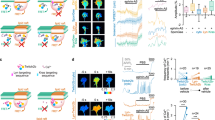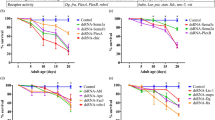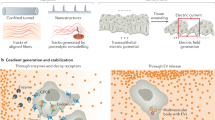Abstract
Many pathfinding axons must locate target fields that are themselves positioned by active migration. A hypothetical method for ensuring that these migrations are coordinated is towing, whereby the extension of axons is entirely dependent on the migration of their target cells. Here we combine genetics and time-lapse imaging in the zebrafish to show that towing by migrating cells is a bona fide mechanism for guiding pathfinding axons in vivo.
This is a preview of subscription content, access via your institution
Access options
Subscribe to this journal
Receive 12 print issues and online access
$209.00 per year
only $17.42 per issue
Buy this article
- Purchase on Springer Link
- Instant access to full article PDF
Prices may be subject to local taxes which are calculated during checkout



Similar content being viewed by others
References
Tessier-Lavigne, M. & Goodman, C.S. Science 274, 1123–1133 (1996).
Hatten, M.E. Annu. Rev. Neurosci. 22, 511–539 (1999).
Weiss, P. Third Growth Symposium 5, 163–203 (1941).
Metcalfe, W.K. J. Comp. Neurol. 238, 218–224 (1985).
Pauls, S., Geldmacher-Voss, B. & Campos-Ortega, J.A. Dev. Genes Evol. 211, 603–610 (2001).
Knaut, H., Werz, C., Geisler, R. & Nusslein-Volhard, C. Nature 421, 279–282 (2003).
Doitsidou, M. et al. Cell 111, 647–659 (2002).
David, N.B. et al. Proc. Natl. Acad. Sci. USA 99, 16297–16302 (2002).
Zhu, Y. et al. Nat. Neurosci. 5, 719–720 (2002).
Xiang, Y. et al. Nat. Neurosci. 5, 843–848 (2002).
Chalasani, S.H., Sabelko, K.A., Sunshine, M.J., Littman, D.R. & Raper, J.A. J. Neurosci. 23, 1360–1371 (2003).
Andermann, P., Ungos, J. & Raible, D.W. Dev. Biol. 251, 45–58 (2002).
Shoji, W., Yee, C.S. & Kuwada, J.Y. Development 125, 1275–1283 (1998).
Gilmour, D.T., Maischein, H.M. & Nusslein-Volhard, C. Neuron 34, 577–588 (2002).
Becker, T., Becker, C.G., Schachner, M. & Bernhardt, R.R. Mech. Dev. 109, 37–49 (2001).
Acknowledgements
We are grateful to J. Campos-Ortega for providing the H2A-F/Z:GFP transgenic line and to F. Peri for discussion and critical reading of the manuscript. This work was supported by the Max-Planck-Gesellschaft.
Author information
Authors and Affiliations
Corresponding author
Ethics declarations
Competing interests
The authors declare no competing financial interests.
Supplementary information
Supplementary Fig. 1
(a) In situ hybridisation showing CXCR4b expression in wild type lateral line primordium at 36 hpf. The G-protein coupled receptor is rapidly down regulated in newly deposited pro-neuromasts (arrows). (b) Endogenous alkaline phosphatase staining of neuromasts in 5 day old larvae. Ody mutants (lower) show strongly reduced number of neuromasts in the posterior lateral line when compared to wild type siblings (upper). (JPG 55 kb)
Rights and permissions
About this article
Cite this article
Gilmour, D., Knaut, H., Maischein, HM. et al. Towing of sensory axons by their migrating target cells in vivo. Nat Neurosci 7, 491–492 (2004). https://doi.org/10.1038/nn1235
Received:
Accepted:
Published:
Issue Date:
DOI: https://doi.org/10.1038/nn1235
This article is cited by
-
CXCL12 and MYC control energy metabolism to support adaptive responses after kidney injury
Nature Communications (2018)
-
Guiding migration of transplanted glial progenitor cells in the injured spinal cord
Scientific Reports (2016)
-
Axon-Schwann cell interactions during peripheral nerve regeneration in zebrafish larvae
Neural Development (2014)
-
Directional tissue migration through a self-generated chemokine gradient
Nature (2013)
-
Effect of NRG1, GDNF, EGF and NGF in the Migration of a Schwann Cell Precursor Line
Neurochemical Research (2010)



